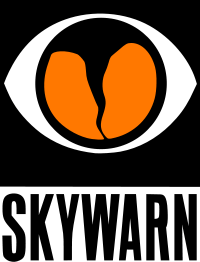Skywarn
| SKYWARN | |
|---|---|
 | |
| Formation | June 18th 1971 |
| Purpose/focus | Severe weather spotting |
| Region served | United States |
| Membership | Volunteer |
| Official languages | English |
| Affiliations | National Weather Service National Oceanic and Atmospheric Administration |
| Website | www.weather.gov/skywarn/ |
SKYWARN is a program of the United States' National Weather Service (NWS). Its mission is to collect reports of localized severe weather. These reports are used to aid forecasters in issuing and verifying severe weather watches and warnings and to improve the forecasting and warning processes and the tools used to collect meteorological data. It consists of a network of severe storm spotters that observe weather conditions and make reports of severe weather to their local NWS offices. These spotters are regularly trained by personnel from the local NWS offices. In many areas, classes are conducted each spring in advance of the coming severe weather season.[1]
Storm spotting
Where severe storms are possible, storm spotting groups such as SKYWARN in the United States coordinate amateur radio operators and localized spotters to keep track of severe thunderstorms and tornadoes. Reports from spotters and chasers are given to the National Weather Service so that they have ground truth information to warn the general public. Spotting provides ground information and localized conditions that the National Weather Service might not know the extent or might not otherwise be aware of. They typically report events, such as structures struck by lightning, rotating wall clouds, funnel clouds—or conditions that exceed specific thresholds, such as extremely strong winds, significant hail or very heavy rainfall. The exact reporting thresholds can vary by region and may even dynamically change during a severe weather event. Spotters also give reports during winter storms, floods, hurricanes, and wildfires.
Other countries have similar programs, such as the Canadian spotting program Canwarn, the SkyWarn UK and the Tornado and Storm Research Organisation (TORRO) programs in the United Kingdom, and Skywarn Europe for several European countries.
Training
The NWS sponsors SKYWARN training sessions in the US. These sessions usually occupy two hours and focus on hazard identification and communication along with spotter strategies and safety. NWS recommends attendance at refresher courses every two years.[2]
Methods of Participation
SKYWARN has long been associated with amateur radio. Many NWS offices maintain an amateur radio station that is manned by amateur radio operators during times of severe weather. This allows licensed amateur radio spotters to transmit their severe weather reports directly to the NWS and receive up-to-date severe weather updates even if regular communications are disrupted or overloaded by the weather emergency. It does, however, require 1) the cooperation of the local WFO, and 2) that the station actually be manned, live, in order for that to work. Depending upon a particular geographic location's capabilities, enthusiasm, and security restrictions, manning a WFO can sometimes prove to be a difficult idea. Ham radio nets can still operate to gather the information, and someone can still then relay that information over the telephone or the Internet.
It should be noted that participation in the SKYWARN program does not, however, require an amateur radio license. SKYWARN was not conceived by, nor is it owned or operated by any amateur radio organization. More than half of all SKYWARN spotters are not licensed amateur radio operators.
The NWS encourages anyone with an interest in public service and access to some method of communication, such as amateur radio, telephone, the Internet, etc. to join the SKYWARN program. Volunteers include police and fire personnel, dispatchers, EMS workers, public utility workers and other concerned private citizens. Individuals affiliated with hospitals, schools, churches, nursing homes or who have a responsibility for protecting others are also strongly encouraged to become spotters.
Those without radio communication capability can still make their reports via cell phone, landline telephone, or the Internet.
New Technology
Some in the spotter community have also discussed the next step in spotting and to include non-Amateur radio operators in SKYWARN operations. One method seeing growth is using the Spotter Network reporting service. This uses the NWS eSpotter service and geo-locates the reports. The resiliency of Internet communications at the onset of a severe weather episode has proven that these communication methods are valuable in SKYWARN operations.[3]
See also
References
- ↑ "NWS Jackson, MS - SKYWARN: Spotter Information". National Weather Service. 2006-03-03. Retrieved 2008-04-21.
- ↑ "Frequently Asked Questions about Storm Spotting". NOAA. Retrieved 2010-05-18.
- ↑ "National Weather Association: Electronic Journal of Operational Meteorology". National Weather Association. 2009-04-30. Retrieved 2009-12-12.
External links
- SKYWARN Homepage
- Index To SKYWARN Web Pages On The Internet
- SKYWARN Recognition Day
- SpotterNetwork Homepage
- Skywarn Email List